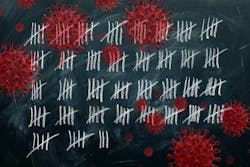The U.S. Food and Drug Administration (FDA) issued an alert to clinical laboratories and healthcare providers in which the agency said that false positive results can occur with antigen tests to detect SARS-CoV-2, particularly when users do not follow the instructions.
Generally, antigen tests are indicated for the qualitative detection of SARS-CoV-2 antigens in authorized specimen types collected from individuals who are suspected of COVID-19 by their healthcare provider within a certain number of days of symptom onset. The FDA said it is aware of reports of false positive results associated with antigen tests used in nursing homes and other settings.
“Healthcare providers and clinical laboratory staff can help ensure accurate reporting of test results by following the authorized instructions for use of a test and key steps in the testing process as recommended by the Centers for Disease Control and Prevention (CDC), including routine follow-up testing (reflex testing) with a molecular assay when appropriate, and by considering the expected occurrence of false positive results when interpreting test results in their patient populations,” the FDA said.
When using antigen tests, the FDA recommends that labs follow instructions in the package insert about handling test cartridges/cards, such as ensuring they are not stored open, and reading test results at the appropriate time.
The agency also recommends that laboratories and healthcare providers:
· Use caution when processing multiple specimens in batch mode because the process may make it challenging to ensure the correct incubation time for each specimen
· Minimize the risks of cross-contamination when testing patient specimens, which can cause false positive results. “Insufficient cleaning of the workspace, insufficient disinfection of the instrument, or inappropriate use of protective equipment (for example, failing to change gloves between patients) can increase the risk of cross-contamination between specimens with subsequent false positive results,” the FDA said.
The FDA also noted that the positive predictive value (PPV) varies with disease prevalence when interpreting results from diagnostic tests. PPV is the percent of positive test results that are true positives. As disease prevalence decreases, the percent of test results that are false positives increase.
For example, a test with 98 percent specificity would have a PPV of just over 80 percent in a population with 10 percent prevalence, meaning 20 out of 100 positive results would be false positive results. “Healthcare providers should take the local prevalence into consideration when interpreting diagnostic test results,” the FDA said.

